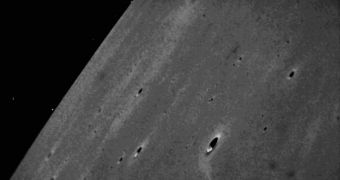The NASA Lunar Atmosphere and Dust Environment Explorer (LADEE) spacecraft may have arrived in orbit around the Moon on October 6, 2013, but it only began taking science images after its instruments underwent their testing and commissioning phases.
For the first time since the orbiter achieved orbital insertion, NASA experts downlinked these test images, earlier this month.
The purpose of this spacecraft is to study the lunar exosphere in great detail, and to understand how dust in the Moon's vicinity behaves and influences Earth's natural satellite. The orbiter will also look for signs of radiations and glows at the lunar dawn, as reported by some Apollo astronauts.
The 248-kilogram (547-pound) spacecraft was launched from the Mid-Atlantic Regional Spaceport (MARS) at the NASA Wallops Flight Facility, in Virginia, aboard a Minotaur V rocket provided by Dulles-based Orbital Sciences Corporation. Takeoff occurred on September 7, 2013.
LADEE is scheduled to spend three months orbiting above the lunar equator. During this time, it will use its dust detector, neutral mass spectrometer, and ultraviolet-visible spectrometer instruments to collect as much data as possible. The orbiter also carries an experimental laser communications terminal, which has already been successfully demonstrated.
The images NASA has recently downloaded from the LADEE camera systems show both star-tracker data and the lunar surface. The tracker information are of critical importance for the mission, since the orbiter uses them to calculate its precise position in space. s
“Star tracker cameras are actually not very good at taking ordinary images. But they can sometimes provide exciting glimpses of the lunar terrain,” says LADEE mission manager, Butler Hine.
The orbiter is managed by scientists at the NASA Ames Research Center (ARC) in Moffett Field, California and the NASA Goddard Space Flight Center (GSFC) in Greenbelt, Maryland.
The image attached to this article was snapped on February 8, as the spacecraft was conducting atmospheric measurements with its wide-angle star-tracker cameras. While not many details of the lunar surface are available, the views may still have some scientific value.
The photo was taken at 23:45 UTC, during the lunar night. The light you see bouncing off the lunar surface is sunlight bouncing off from Earth, NASA experts explain. LADEE is currently traveling over the lunar surface at a speed of about 100 kilometers (60 miles) per minute.

 14 DAY TRIAL //
14 DAY TRIAL //